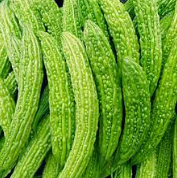In vivo Effect of Momordica charantia on Dipeptidyl Peptidase-4 Activity in Diabetic Rats
Main Article Content
Abstract
Downloads
Article Details

This work is licensed under a Creative Commons Attribution-NonCommercial-NoDerivatives 4.0 International License.
How to Cite
References
Perkeni. Guidelines for the management and prevention of type 2 diabetes mellitus in Indonesia 2021. Published online 2021:46.
Ling C. Epigenetic regulation of insulin action and secretion – role in the pathogenesis of type 2 diabetes. J Intern Med. 2020;288(2):158-167. doi:10.1111/joim.13049
International Diabetes Federation. IDF Diabetes Atlas. 2021;102 doi:10.1016/j.diabres.2013.10.013
Kementrian Kesehatan Republik Indonesia. Infodatin 2020 Diabetes Mellitus. Published online 2019.
Goyal R, Jialal I. Diabetes Mellitus, Type 2. 2020. doi:10.1016/b978-3-437-42502-8.00154-6
Punthakee Z, Goldenberg R, Katz P. Definition, Classification and Diagnosis of Diabetes, Prediabetes and Metabolic Syndrome. Can J Diabetes. 2018;42:S10-S15. doi:10.1016/j.jcjd.2017.10.003
Kelly SD, Neary SL. Ominous Octet and Other Scary Diabetes Stories: The Overview of Pathophysiology of Type 2 Diabetes Mellitus. Physician Assist Clin. 2020;5(2):121-133. doi:10.1016/j.cpha.2019.11.002
Bhat GA, Khan HA, Alhomida AS, Sharma P, Singh R, Paray BA. GLP-I secretion in healthy and diabetic Wistar rats in response to aqueous extract of Momordica charantia. BMC Complement Altern Med. 2018;18(1). doi:10.1186/s12906-018-2227-4
Singh R, Bhat GA, Sharma P, Bhat A. GLP-1 secretagogues potential of medicinal plants in management of diabetes. J Pharmacogn Phytochem. 2015;4(1):197-202.
St. Onge EL, Miller S, Clements E. Sitagliptin/metformin (Janumet) as combination therapy in the treatment of type-2 diabetes mellitus. P and T. 2012;37(12):699-708.
Peter EL, Nagendrappa PB, Hilonga S, Tuyiringire N, Ashuro E, Kaligirwa A, Sesaazi CD. Pharmacological reflection of plants traditionally used to manage diabetes mellitus in Tanzania. J Ethnopharmacol. 2021;269:113715. doi:10.1016/j.jep.2020.113715
Saeed F, Sultan MT, Riaz A, Ahmed S, Bigiu N, Amarowicz R, Manea R. Bitter melon (Momordica charantia l.) fruit bioactives charantin and vicine potential for diabetes prophylaxis and treatment. Plants. 2021;10(4). doi:10.3390/plants10040730
Parawansah P, Sudayasa IP, Syarifin AN, Eso A, Nuralifah N, Fathanah WO, Sandra F. Momordica charantia L. fruit fractions inhibit malondialdehyde level and regenerate hepatic damage of hyperglycemic rats. Indones. Biomed. J. 2020;12(1):57-61. doi:10.18585/INABJ.V12I1.963
Surya O, Hendro W, Yudhanto E, Himawan AB, Adespin DA. Effect of Momordica charantia fruit ethanolic extract on malondialdehyde ( MDA ) level in blood of Sprague-Dawley rats induced by 7, 12-dimethylbenz [ a ] anthracene. Diponegoro Med. Jour. 2022;11(1):32-6.
Poovitha S. In vitro and in vivo α-amylase and α-glucosidase inhibiting activities of the protein extracts from two varieties of bitter gourd (Momordica charantia L.). BMC Complement Altern Med. 2016;16. doi:10.1186/s12906-016-1085-1
Ayoub SM. Evaluation of hypoglycemic effect of Momordica charantia extract in distilled water in streptozotocin-diabetic rats. Braz. J. Vet. Pathol. 2013;6(2):56-64. https://api.elsevier.com/content/abstract/scopus_id/84881620563
Raza H, John A. Streptozotocin-induced cytotoxicity, oxidative stress and mitochondrial dysfunction in human hepatoma HepG2 cells. Int J Mol Sci. 2012;13(5):5751-5767. doi:10.3390/ijms13055751
Zhu Y. Effects of bitter melon (Momordica charantia L.) on the gut microbiota in high-fat diet and low dose streptozocin-induced rats. Int J Food Sci Nutr. 2016;67(6):686-695. doi:10.1080/09637486.2016.1197185
Kusniawati MA. Systematic Review of the Activity of Bitter Gourd Fruit (Momordica charantia L.) Against Antidiabetic Molecular Targets. Indones. J. Pharm. Published 18(2):141-151. DOI:10.31001/jfi.v18i2.974
Mahwish. Bitter melon (Momordica charantia l.) fruit bioactives charantin and vicine potential for diabetes prophylaxis and treatment. Plants. 2021;10(4). doi:10.3390/plants10040730
Oyelere SF. A detailed review on the phytochemical profiles and antidiabetic mechanisms of Momordica charantia. Heliyon. 2022;8(4). doi:10.1016/j.heliyon.2022.e09253
Perumal N, Nallappan M, Shohaimi S, Kassim NK, Tee TT, Cheah YH. Synergistic antidiabetic activity of Taraxacum officinale (L.) Weber ex F.H. Wigg and Momordica charantia L. polyherbal combination. Biomed Pharmacother. 2022;145. doi:10.1016/j.biopha.2021.112401
Arif R. Molecular Docking and Simulation Studies of Antidiabetic Agents Devised from Hypoglycemic Polypeptide-P of Momordica charantia. Biomed Res Int. 2021;2021. doi:10.1155/2021/5561129
Elekofehinti OO. Momordica charantia nanoparticles potentiate insulin release and modulate antioxidant gene expression in pancreas of diabetic rats. Egypt. J. Med. Hum. Genet. 2022;23(1). doi:10.1186/s43042-022-00282-0
Latigui A, Bouzidi NK, Hassini N, Benmetir S. Exploration of Novel Type 2 Antidiabetic Agents: Molecular Docking and Toxicity Assessment of Polyphenolic Compounds for Improved Therapeutic Potential. Trop. J. Nat. Prod. Res.. 2024;8(7):7755-7758. doi:10.26538/tjnpr/v8i7.19
Kabir N, Umar IA, James DB, Inuwa HM, Atiku MK. Antidiabetic potentials of aqueous leaf extracts of Momordica balsamina linn and Leptadenia hastata (Pers) decne alone and in combination in streptozotocin-induced diabetic rats. Trop. J. Nat. Prod. Res. 2019;3(1):10-16. doi:10.26538/tjnpr/v3i1.3


